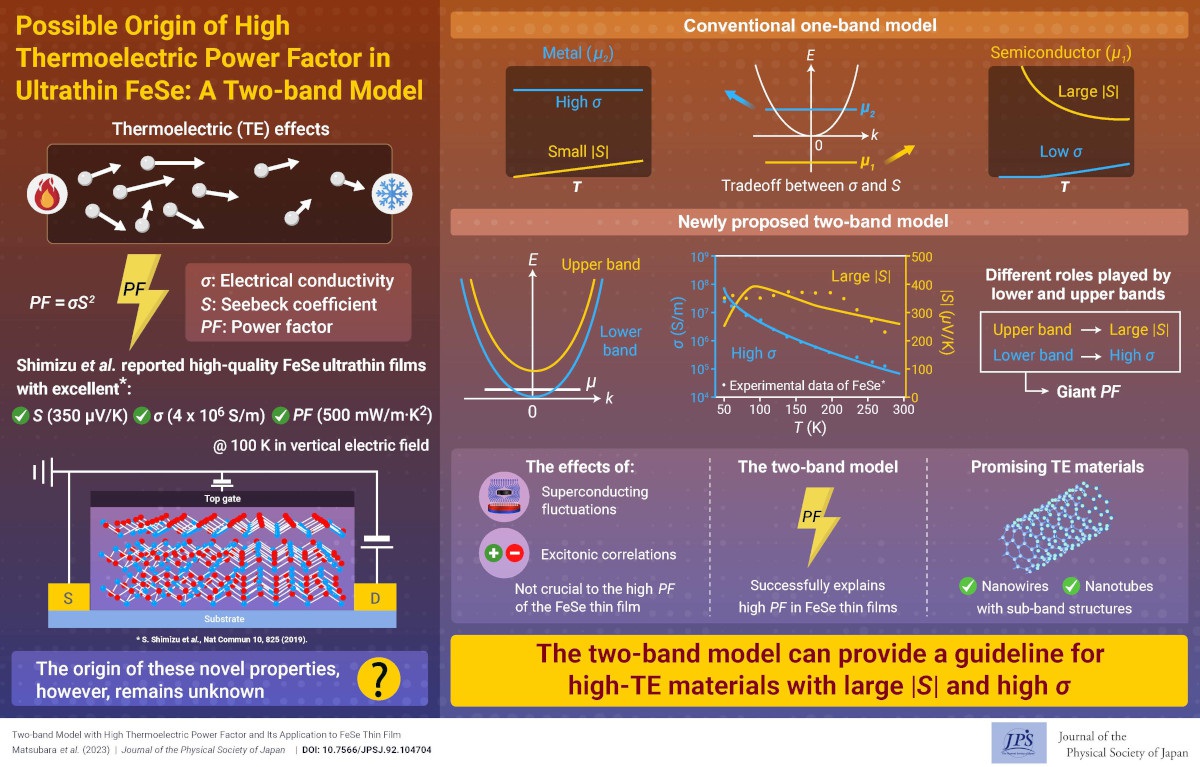Possible Origin of High Thermoelectric Power Factor in Ultrathin FeSe: A Two-band Model
© The Physical Society of Japan
This article is on
J. Phys. Soc. Jpn.
92,
104704
(2023)
.
The high thermoelectric power factor observed in ultrathin FeSe can be theoretically explained by a two-band model with chemical potential between upper and lower band bottoms.

Thermoelectric (TE) materials have recently garnered significant attention toward realizing a low-carbon society. The maximum power of a TE material can be characterized by the power factor (PF), which is determined as PF = σS2, where σ and S denote the conductivity and Seebeck coefficient, respectively. Thus, both a large |S| and high σ are needed for the development of high-PFmaterials. However, it is well known that there is a tradeoff between |S|and σ; |S| is large but σ is small in semiconductors, and vice versa in metals.
Recently, Shimizu et al. reported that a high-quality ultrathin FeSe under a perpendicular electric field  exhibits a high PF of 500 mW/(m·K2) at 100 K1). The film exhibits metallic character, with σ~4 × 106 S/m at 100 K and becomes a superconductor below 50 K. In contrast, |S| exhibits a large value of 350 μV/K, similar to that of a semiconductor. Such a high PF with both a large |S| and high σ cannot be explained in terms of a conventional one-band model. Thus, we proposed a two-band model with a chemical potential between upper and lower band bottoms as a simple theoretical model and elucidated the high PF. Here, we assumed that the two-band structure with finite splitting is realized by field
exhibits a high PF of 500 mW/(m·K2) at 100 K1). The film exhibits metallic character, with σ~4 × 106 S/m at 100 K and becomes a superconductor below 50 K. In contrast, |S| exhibits a large value of 350 μV/K, similar to that of a semiconductor. Such a high PF with both a large |S| and high σ cannot be explained in terms of a conventional one-band model. Thus, we proposed a two-band model with a chemical potential between upper and lower band bottoms as a simple theoretical model and elucidated the high PF. Here, we assumed that the two-band structure with finite splitting is realized by field  in the ultrathin FeSe.
in the ultrathin FeSe.
The present two-band model provides a guideline for designing high TE materials. For instance, nanowires and nanotubes with nanosized diameters are also promising materials with large |S| and high σ values because of sub-band structures. In contrast to FeSe thin films,  tunes the chemical potential without affecting the sub-band gap suited for optimization of TE properties.
tunes the chemical potential without affecting the sub-band gap suited for optimization of TE properties.
(Written by M. Matsubara on behalf of all the authors.)
J. Phys. Soc. Jpn.
92,
104704
(2023)
.
Share this topic
Fields
Related Articles
-
Exploring the Vibrant Interplay of Machine Learning and Physics
Cross-disciplinary physics and related areas of science and technology
Electron states in condensed matter
Elementary particles, fields, and strings
Mathematical methods, classical and quantum physics, relativity, gravitation, numerical simulation, computational modeling
Statistical physics and thermodynamics
Superconductivity
2025-3-13
This Journal of the Physical Society of Japan Special Topics edition explores how physics and machine learning complement each other and can solve unresolved problems in physics.
-
Bayesian Insights into X-ray Laue Oscillations: Quantitative Surface Roughness and Noise Modeling
Measurement, instrumentation, and techniques
Structure and mechanical and thermal properties in condensed matter
2025-2-14
This study adopts Bayesian inference using the replica exchange Monte Carlo method to accurately estimate thin-film properties from X-ray Laue oscillation data, enabling quantitative analysis and appropriate noise modeling.
-
Hyperuniform and Multifractal States in Bosonic Quasicrystalline Systems
Statistical physics and thermodynamics
Structure and mechanical and thermal properties in condensed matter
2025-2-10
Quantum states can be categorized as hyperuniform or multifractal based on electronic characteristics. This study demonstrates that bosonic quasicrystalline systems exhibit hyperuniform or multifractal quantum states.
-
Exploring Materials without Data Exposure: A Bayesian Optimizer using Secure Computation
Cross-disciplinary physics and related areas of science and technology
Measurement, instrumentation, and techniques
2025-2-6
Secure computation allows the manipulation of material data without exposing them, thereby offering an alternative to traditional open/closed data management. We recently reported the development of an application that performs Bayesian optimization using secure computation.
-
Triangular Lattice Magnet GdGa2: Spin Cycloids and Skyrmions
Cross-disciplinary physics and related areas of science and technology
Electronic transport in condensed matter
Magnetic properties in condensed matter
2025-2-3
Careful measurements were conducted on the hexagonal magnet GdGa2 to reveal the experimental signatures of ultrasmall spin cycloids and of a potential Néel-type skyrmion lattice phase induced by a magnetic field.




